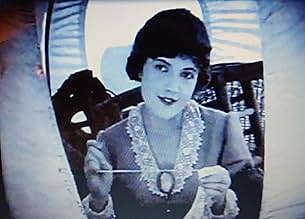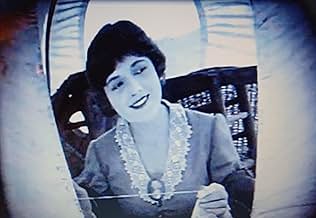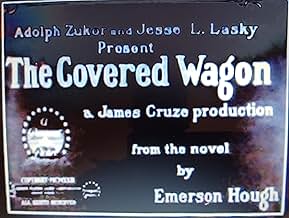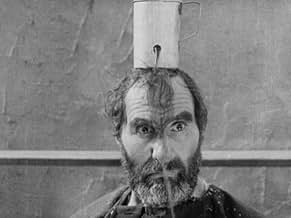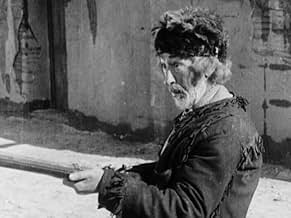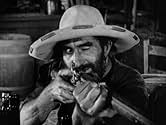अपनी भाषा में प्लॉट जोड़ेंTwo wagon caravans converge at what is now Kansas City, and combine for the westward push to Oregon. On their quest the pilgrims will experience desert heat, mountain snow, hunger, and India... सभी पढ़ेंTwo wagon caravans converge at what is now Kansas City, and combine for the westward push to Oregon. On their quest the pilgrims will experience desert heat, mountain snow, hunger, and Indian attacks. To complicate matters further, a love triangle develops, as pretty Molly must c... सभी पढ़ेंTwo wagon caravans converge at what is now Kansas City, and combine for the westward push to Oregon. On their quest the pilgrims will experience desert heat, mountain snow, hunger, and Indian attacks. To complicate matters further, a love triangle develops, as pretty Molly must chose between Sam, a brute, and Will, the dashing captain of the other caravan. Can Will ov... सभी पढ़ें
- पुरस्कार
- कुल 6 जीत
- Indian
- (काटे गए सीन)
- Minor Role
- (बिना क्रेडिट के)
- Indian
- (बिना क्रेडिट के)
- Pioneer Child
- (बिना क्रेडिट के)
- Violinist at funeral
- (बिना क्रेडिट के)
- Girl
- (बिना क्रेडिट के)
- Indian
- (बिना क्रेडिट के)
- Minor Role
- (बिना क्रेडिट के)
फ़ीचर्ड समीक्षाएं
Here for the first time, we have the wagon train of eastern settlers trekking west in search of a new land and a new start. We have the circling of the wagons in preparation for the Indian attack, the attack itself and the ride to the rescue of the besieged wagons.
Cruze captures the feel of what a real wagon train journey must have been like. The long lines of slow moving covered wagons, the dusty trails, life and death situations on the prairie, as well as the celebrations around the campfire.
The sub-plot of boy-girl-villain is "B" western calibre, however, the players carry it of admirably. J. Warren Kerrigan as the hero is adequate but not memorable. The lovely Lois Wilson as the heroine and a young Alan Hale as the villain are much better. It is curious that the Cruze portrayed legendary mountain man Jim Bridger (Tully Marshall) as an absent-minded, liquor swilling comedy relief.
The ending is strictly Hollywood. Boy gets girl of course and the villain is defeated, but I thought that the final shoot-out left a little to be desired.
Despite its apparent faults, The Covered Wagon remains today as powerful a film as it must have been in 1923.
During the river-crossing scene where horses were hauling the wagons across a deep ford, actress Lois Wilson was so traumatized witnessing two horses drowning she returned to her tent and didn't work the rest of day.
"The Covered Wagon" was the final of many Lois Wilson and J. Warren Kerrigan movies where they paired up as a romantic couple. The irony of the matrimony roles they played through that span, neither one actually married in real life. Wilson, appearing in over 150 movies, made the transition to sound, but retired in 1941 over the type of roles she was offered. She wrapped up her acting career in three network soap operas, including 'The Guiding Light' and 'The Secret Storm.' Actor Kerrigan's career was sinking like a rock when he receive the romantic lead in "The Covered Wagon." A rising star in the mid-1910's, he made an insensitive comment when the United States entered the Great War in 1917, stating actors, musicians, great writers and other artists shouldn't be sacrificed on the battle front. "I think that first they should take the great mass of men who aren't good for anything else, or are only good for the lower grades of work," he callously said. That statement and the fact he was living with his mother as well as a partner, actor James Vincent, in the same house, sunk his standing in Hollywood. His friendship with director James Cruz got him the lead role in "The Covered Wagon." The movie was President Warren G. Harding's favorite film as well as the creator of Godzilla, Japanese producer Tomoyuki Tanaka. "The Covered Wagon" was also nominated for American Film Institute's '100 Most Thrilling Film Ever Made' category.
*** (out of 4)
Highly entertaining and influential Western about a large wagon train that starts off in the Midwest and plans to head out West and up into Oregon. Along the way there are various internal battles as well as dangerous issues with Indians as well as other problems with their journey.
One could watch THE COVERED WAGON today and say that it doesn't have anything original to it but they would be missing the point. This was a very original movie when it was originally released and it has been copied so many times since 1923 that some people might forget or just overlook the fact that the rules were formed here for all future Westerns. There are certainly some flaws in the film but at the same time there's no question that this is a highly entertaining movie and one that works on many levels.
As I said, the film is basically about this large wagon train heading out West and we see the various problems that happen on the journey. This includes a love triangle between the three main characters. You've got the good guy Will (J. Warren Kerrigan), the bad guy Sam (Alan Hale) and then there's Molly (Lois Wilson) who both want. This leads to some very fun scenes including an extended fight sequence that was perfectly directed by James Cruze. You've also got some other great action including a river crossing, a buffalo hunt and a sequence where the wagons are attacked by Indians.
There are some flaws with the film including Kerrigan not being that strong as the lead. I thought he gave a fine performance and I thought he was good to watch but at the same time I think the film would have benefited from a stronger lead. Hale was wonderful as the villain and Wilson was cute enough for what she was asked to do. The film featured some very good cinematography and I'd also argue that the editing itself was good. The locations were great and while the story itself wasn't the strongest, it was at least good enough to hold your attention throughout.
THE COVERED WAGON is certainly a landmark Western and one that influenced everything that was to follow. The movie isn't perfect but it's about as entertaining as you can get.
James Cruze directed the production and failed to enliven or distinguish any of the much needed action sequences, whether it be a big scene, an Indian attack on the wagon train, or a smaller one (a fist fight between Kerrigan and Hale).
The film is noteworthy, however, for its photography, and in showing the far flung vistas on the horizon, does convey a sense of bigness. Also enlivening the film to a degree are the performances of Tully Marshall as a fur trapper and, in particular, Ernest Torrence as a grizzled wagon scout, stereotypes as they may be. Torrence and Marshall are entertaining enough that eight years later they would be reunited for essentially the same roles in a 1931 wagon train tale of negligible entertainment value, Fighting Caravans.
The Covered Wagon might have been considered to be a big deal for the film world in 1923 but today this trip put west is, I'm sorry to say, is just not a standout. Maybe I just expected more because Paramount silent are so hard to find and, many times, they really are standouts.
क्या आपको पता है
- ट्रिवियाAlthough there are scenes that show huge buffalo herds with what looks like thousands of animals, large buffalo herds didn't exist at the time this film was made (1923). The buffalo had been hunted almost to extinction during the late 19th century, with millions of them being slaughtered, and its numbers hadn't yet increased enough to comprise large herds. Cameraman Karl Brown used small lead castings of various sizes of buffalo, placed the larger ones toward the camera and used diminishing sizes in the background for depth. All the castings were mounted on a series of moving chains, those in the rear moving very slowly while the rows of chains moved increasingly faster as they neared the foreground. The castings were hinged so that they moved with an undulating motion, which made them appear to be actual buffalo running. The chains were placed out of view and the mechanical buffalo were placed in front of a painted background containing distant buffalo. The result was a scene of "thousands" of buffalo, when in reality most of them were basically statues.
- गूफ़Jim Bridger is presented in this film as being a bigamist with two Indian wives. Bridger actually married three times, all to Indian women, but the first died before he married the second and the second died before he married the third.
- कनेक्शनFeatured in The House That Shadows Built (1931)
टॉप पसंद
- How long is The Covered Wagon?Alexa द्वारा संचालित
विवरण
बॉक्स ऑफ़िस
- बजट
- $7,82,000(अनुमानित)
- दुनिया भर में सकल
- $31
- चलने की अवधि1 घंटा 38 मिनट
- रंग
- ध्वनि मिश्रण
- पक्ष अनुपात
- 1.33 : 1
इस पेज में योगदान दें



